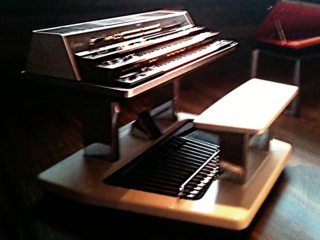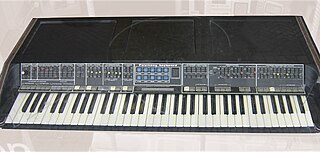
An electronic musical instrument or electrophone is a musical instrument that produces sound using electronic circuitry. Such an instrument sounds by outputting an electrical, electronic or digital audio signal that ultimately is plugged into a power amplifier which drives a loudspeaker, creating the sound heard by the performer and listener.

An electronic keyboard, portable keyboard, or digital keyboard is an electronic musical instrument based on keyboard instruments. Electronic keyboards include synthesizers, digital pianos, stage pianos, electronic organs and digital audio workstations. In technical terms, an electronic keyboard is a rompler-based synthesizer with a low-wattage power amplifier and small loudspeakers.

Oberheim is an American synthesizer manufacturer founded in 1969 by Tom Oberheim.

ARP Instruments, Inc. was a Lexington, Massachusetts manufacturer of electronic musical instruments, founded by Alan Robert Pearlman in 1969. It created a popular and commercially successful range of synthesizers throughout the 1970s before declaring bankruptcy in 1981. The company earned a reputation for producing excellent sounding, innovative instruments and was granted several patents for the technology it developed.
Keytar is a keyboard instrument similar to a synthesizer or MIDI controller that is supported by a strap around the neck and shoulders, similar to the way a guitar is held.

An electric organ, also known as electronic organ, is an electronic keyboard instrument which was derived from the harmonium, pipe organ and theatre organ. Originally designed to imitate their sound, or orchestral sounds, it has since developed into several types of instruments:

The ARP 2600 is a subtractive synthesizer first produced by ARP Instruments, Inc in 1971.

The microKORG is a MIDI-capable digital synthesizer/vocoder from Korg featuring DSP-based analog modelling. The synthesizer is built in such a way that it is essentially a Korg MS-2000 with a programmable step arpeggiator, a less advanced vocoder, lack of motion sequencing, lack of an XLR microphone input, and in a smaller case with fewer real-time control knobs.

The Polymoog is a hybrid polyphonic analog synthesizer that was manufactured by Moog Music from 1975 to 1980. The Polymoog was based on divide-down oscillator technology similar to electronic organs and string synthesizers of the time.

Cyclone is the eighth studio album by Tangerine Dream and the first in their canon to feature proper vocals and lyrics. The cover is a painting by band leader Edgar Froese.
Polyphony is a property of musical instruments that means that they can play multiple independent melody lines simultaneously. Instruments featuring polyphony are said to be polyphonic. Instruments that are not capable of polyphony are monophonic or paraphonic.

The Solina String Ensemble, also marketed as the ARP String Ensemble, is a fully polyphonic multi-orchestral synthesizer with a 49-key keyboard, produced by Eminent BV. It was distributed in the United States by ARP Instruments from 1974 to 1981. The sounds it incorporates are violin, viola, trumpet, horn, cello, and contrabass. The keyboard uses 'organ style' divide-down technology to make it polyphonic. The built-in chorus effect gives the instrument its distinctive sound.

The ARP Quadra was a 61-key analog synthesizer produced by ARP Instruments, Inc. from 1978 to 1981. The machine combined pre-existing products: the Omni, Odyssey, a Solina-esque string synthesizer unit, a phaser and a divide-down organ with ADSR envelope, and a 4075 24 db low pass filter into one box. It has four sections. Bass is on the bottom two octaves, has two unison bass circuits, with AR and a single pole low pass filter and a related AD envelope for cutoff. A string section is similar to the ARP Omni. Poly Synth, and a two voice Lead Synth similar to the Odyssey and a five way mixer with four unit outputs, a stereo pair, a line mono and an XLR out.

The ARP Omni was a polyphonic analog synthesizer manufactured by ARP Instruments, Inc.

A guitar synthesizer is any one of a number of musical instrument systems that allow a guitarist to access synthesizer capabilities.
The Freeman String Symphonizer was a 5-octave synthesizer of the 1970s. It was finally manufactured by the Chicago Musical Instrument Co. and was also known as the Cordovox CSS. Its sound was related to that of the ARP String Ensemble – cool, glassy-sounding strings. Eventually, its inventor Ken Freeman tried to strike a deal with the company Ling but they abandoned their interest in it. Lowrey a division of CMI finally struck a deal after some deliberation.
The Roland RS-202 was a polyphonic string synthesizer, introduced by Roland in 1976. It was the successor to the Roland RS-101, released in 1975.
The history of home keyboards lies in mechanical musical instrument keyboards, electrified keyboards and 1960s and 1970s synthesizer technologies.
The Nautilus is a music workstation manufactured by Korg, a successor to Kronos 2, which comes with Kronos' nine different synthesizer sound engines and other similar features. It was announced in November 2020 with availability in January 2021.














